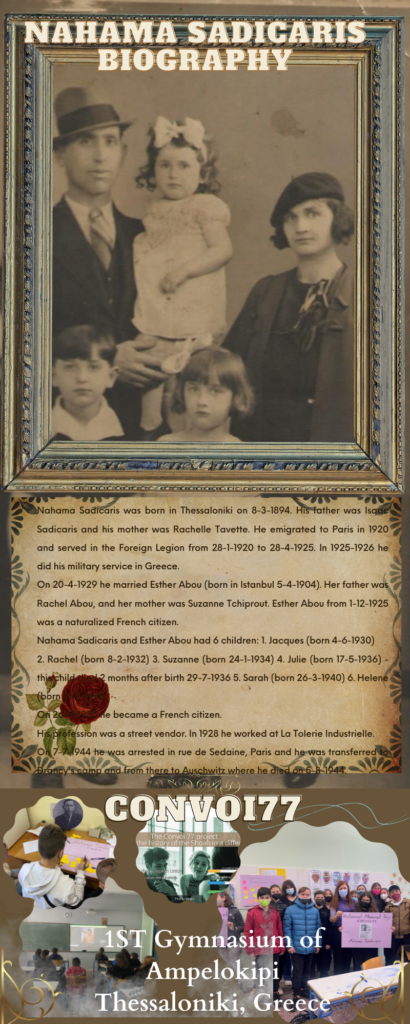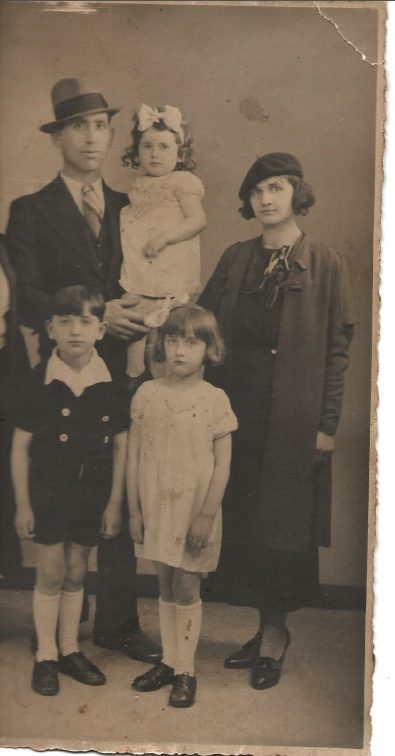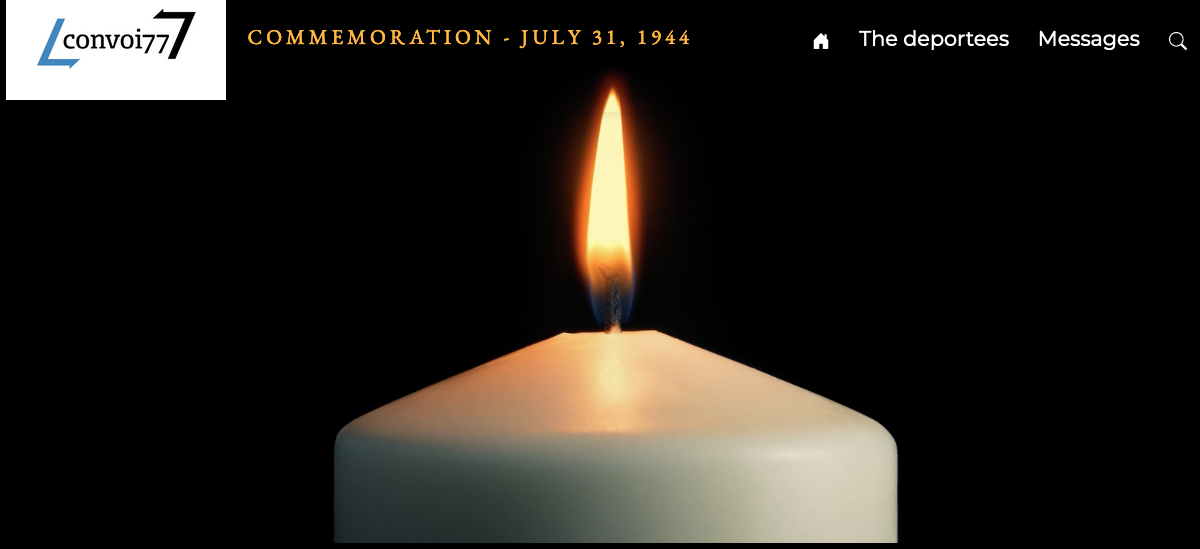Nahama SADICARIS
Photo of the Sadaris family: Family archives – Thierry Sadicaris
The first part of this biography was written by a group of students from the Odysseas Elytis 1st Junior High School of Ampelokipoi, in Thessaloniki, Greece, with the guidance of their teacher, Ms. Papachristou.
The second piece was written by Karine, Nahamas Sadicaris’s granddaughter, (Hélène’s daughter), in 2024.
Nahama Sadicaris was born in Thessaloniki on March 8, 1894. His parents were Isaac Sadicaris and Rachelle Tavette. He emigrated to Paris in 1920 and served in the French Foreign Legion from January, 1920 to April 28, 1925. In 1925-1926 he did his national service in Greece.
On April 20, 1929 he married Esther Abou, who was born in Istanbul on April 5, 1904. Her father was Rachel Abou, and her mother was Suzanne Tchiprout. Esther Abou was naturalized as a French citizen on December 1, 1925.
Nahama Sadicaris and Esther Abou had 6 children:
1. Jacques (born June 4, 1930)
2. Rachel (born February 8, 1932)
3. Suzanne (born January 24, 1934)
4. Julie (born May 17, 1936, but died two months later on July 29, 1936)
5. Sarah (born March 26, 1940)
6. Helene (born May 16, 1943)
On November 26, 1930 Nahama Sadaris became a French citizen.
He initially worked as a street vendor. In 1928, he was working for La Tolerie Industrielle. Prior to 1930, his home address was 127, rue de Bulets. After he got married, he and his wife moved to 18, Rue Charles Lauth in the 18th district of Paris.
On February 22, 1943, the Ministry of Justice checked the legality of his naturalization. On August 17, 1943 , it was decided that France did not consider him to be “undesirable” and that he was legally a French citizen.
On July 7, 1944 Nahama Sadicaris was arrested on rue Sedaine in the 11th district of Paris. He was taken to Drancy camp and from there was deported to Auschwitz, where he died. His official date of death was later declared to be August 5, 1944.
His wife, Esther, died on February 28, 1993.
At the request of his daughter, Rachel Sadicaris, Nahama was awarded the title “Mort en deportation” (Died during deportation) on March 13, 1995. Rachel was living at 8, rue François Couperin, 95320 Saint Leu La Foret at the time.
Rachel Sadicaris died on May 30, 2009.
At the time of writing, Rachel’s son was living in Belgium, as were several other members of the Sadicaris family. Helene was still alive, but unfortunately, she was not able to give us any further information.`
Nahama Sadicaris, by his grandaughter, Karine
Nahama. A man whose identity was stolen by the number 77, the number of the convoy that took him to the “darkness and fog” of the death camps. That same evening, the convoy crossed the river Rhine, (…) and on the third night (August 2-3), 1300 people got off the train and onto a platform. It was pitch-dark, with German soldiers everywhere, spotlights shining down on them: “go right, go left”: on one side, the young, fit people were lining up and on the other, people were being loaded into trucks. An ambulance with a red cross symbol on the side, filled with canisters of Zyklon B gas, followed behind, in order to mislead them. Nahama, then aged 50, was almost certainly sent straight from the ramp in Birkenau to the gas chambers.
In Paris, not long before the liberation, you followed the Allied troops’ advance by putting little American flags on a big map. You went out to buy some meat for your children, with exactly two hundred and ninety-five old French francs in your pocket. I see this as I examine the faded receipt from Drancy camp, dated Friday July 7. This little scrap of paper is the last link that binds us together: my fingers run over the words, I look into your eyes, I put myself in your shoes. Nahama, still alive, still breathing, just standing there in front of the chief of police in the internment camp.
On Saturdays and Sundays, smartly dressed in his much-loved navy-blue overcoat, white scarf and bowler hat, Nahama would head off to the 11th district of Paris. He always used to stop off at the café on the corner of rue Sedaine, where he’d become a regular. He liked to meet up with his friends there, then go home with something to eat, maybe some cheese or some halva. But then one day, the café was raided, and his fate was sealed. His feet were sticking out from under the bench where he and another man were hiding.
When he was arrested, time flew by at an alarming rate! It was a Friday evening, and his wife Estréa was worried that she would never see her husband come home again. That night, without thinking, she decided to spend one last night in the apartment with her children.
The next morning, 14-year-old Jacques got on his bike and sped off to tell uncle Jacques’ wife, Aunt Lucienne, who was coming to visit, what had happened. In their apartment on rue Charles Lauth, amid all the confusion, Estréa kept repeating the same thing:
“Lucienne, they’ll be here soon, Lucienne, we have to leave! We need to get out of here right away!” The family fled, wandering the neighborhood and the surrounding area. In the afternoon, the children went to a tea party at the Charles Hermite school and made the most of the chance to have a bite to eat. One of Rachel’s girlfriends was there, and told her:
“Don’t go home, there are policemen on motorbikes outside”
Their apartment had been sealed up.
On the evening of Saturday 8th, the four oldest children went to spend the night at the UGIF (Union Générale des Israelites de France, or General Union of French Jews) shelter on rue Secrétan. Estréa and her one-year-old daughter Hélène went into hiding with a neighbor on the ground floor of their building, a Ms. Maerten, who was later named one of the Righteous Among the Nations.
Memories of the night of July 8 to 9 would haunt people forever: lives were turned upside down in a chain reaction triggered by the “Quidamus effect”: as in a domino effect, one single man, a “mere mortal”, a “Quidam”, can sometimes, whether knowingly or inadvertently, change things on an unforeseen scale.
The Gestapo [who now knew Nahama’s address] came down on the building in force on July 18. There were trucks in the streets, with headlights and searchlights shining into the courtyard and onto the front of the building. The Grimberg family, the father, his wife Esther, their four children, Monique, who was just 2, Nicou, Renée and Maurice, who was 17, and the Blumberg family, the parents, Léonne, one of the daughters, and the boys, André, who was almost 16 and his brother Serge, were all arrested. Simone was not at home at the time. Maurice tried to escape by jumping out of a window overlooking the janitor’s lodge, but failed.
These were families that Estréa knew well: Rose Blumberg was also born in Istanbul. Pregnant and approaching full term, she was about to have her baby. Nicou was Sarah’s age, and the older children often spent time together. Serge, who would be 14 in a few days’ time, was Jacques’ friend. All of them were rounded up and taken away.
Nahama had been caught first.
Estréa had spent the first night with her family in her apartment. On the second night, she and her daughter Hélène had escaped a tragic fate. On July 9, they fled to a mother-and-daughter shelter, where they stayed until Paris was liberated.
In Drancy camp (or was it in Auschwitz?), Mr. Blumberg met Nahama and the two men got into a fight. He was understandably angry: he felt that his family had been destroyed because Nahama had been careless and got himself arrested. His little boy, Maiu (Alain-Louis), was born on July 17 and deported in a little muslin-lined crate when he was barely two weeks old.
Mr. Blumberg, who survived Auschwitz and returned to France, later said:
“Nahama Sadicaris, I never want to hear that name ever again!”
What happened between them? Mr. Blumberg was unwilling to tell us, so we were left in the dark. This is not a criticism, however: we understand that every time we have to talk about something, we have to relive our suffering all over again.
While he was in Drancy, Nahama managed to send a note to Estréa via his sister-in-law, Aunt Lucienne. The message read, “I know the children are safe, I’m in good spirits”.
When the Gestapo questioned Aunt Lucienne, who was Catholic, about her in-laws and her Jewish husband, she told them that she had grown “fed up with him, and that they were now separated”. Jacques had several fake identity cards. Once, during an identity check, he almost got caught because he had forgotten which of the cards he was carrying that day and what name he should give! As for Salomon, who drove a milk delivery truck, a workmate of his reported him, after which he fled to Puy en Velay, in the Haute-Loire department of France, together with his wife, Sarah, who was also his cousin.
Did Nahama hear the guards’ whistles as one bus after another arrived in Drancy with its human cargo? As he looked out over the courtyard from the upper floors of the U-shaped building, he must have scanned the faces of the newly-arrived children, dreading the possibility that he might recognize one of his own. For between July 21 and 25, 1944, in the dead of night, the SS Captain Aloïs Brunner, who was responsible for Jewish issues in the Paris area and was also the commandant of Drancy camp, had hundreds of children aged 3 to 14 arrested in the “mousetraps” that the UGIF children’s homes had become. There was a shortage of Jewish flesh to fill the cattle cars, and he wanted fill the next convoy to the limit. The hungry SS minotaur demanded children. On July 31, a huge convoy delivered fresh food for the Nazi monster.
A lucky star must have been watching over Nahama’s children: they left the UGIF shelter in the Lucien de Hirsch school on rue Secrétan the evening before a roundup took place there. On the night of Friday July 21 to Saturday July 22, the Nazis burst into the school and took away all eighty children and the staff who were taking care of them.
The children arrived at a building in the heart of the countryside, the Château de Challeau in Dormelles, near the town of Montereau in the Seine-et-Marne department of France. It has now been converted into an exclusive retirement home, set in peaceful parkland. Sarah remembers a grand staircase with wide steps. At four years old, it was difficult not to slip up when her first name was changed to Simone and Rachel’s was changed to Renée, while Suzanne and Jacques kept their original names. Hidden discreetly among a group of local children, they helped out in the fields, picking beetle-infested potatoes. The Colorado beetles bred rapidly and ravaged the crop as swiftly as the Germans who were invading the land. Both species were on the increase. The black and yellow striped insects were everywhere, creating a nightmarish vision of a shapeless, swarming mass. Fortunately, the Resistance rallied round and systematically eradicated the pests.
A doctor was put in charge of caring for the group. Scissors in hand, he was about to cut Sarah’s cute, girlish curls when Rachel, her older sister, intervened, not wanting to see her lose the last remaining trace of her carefree, innocent childhood. She somehow felt that Sarah was still an extension of their absent mother. The doctor replied: “Well, young lady, I’ll teach you a lesson, I’ll cut your hair instead”, and then he relieved her of her long blond hair.
This doctor was of no help whatsoever. Another little girl wrote a letter to her mother complaining about the hardships of rural life. The letter, which of course the staff intercepted and read, said: “The food here is really awful, and if you don’t come and get me, I’ll tell them I’m Jewish”. The doctor then proceeded to interrogate the children in an attempt to ferret out the Jews, and asked them: “Would you say your prayer for me?” Rachel, who had been rehearsing with the girls in her room, got it just about right. But what would become of the others? The doctor was about to report them. They had to get away. The manager of the home arranged their escape. That night, a red-haired man led a dozen or so children across the fields. As they ran, dragging their luggage behind them, the suitcases burst open at random: the only way their lives would be saved was let go of everything that was holding them back
The train back to Paris was packed with German soldiers. It stopped unexpectedly from time to time due to Allied bombing. The journey seemed to take forever, and with the Germans on board, the children knew they must not give themselves away when they were so close to the finish line! Rachel, with her short hair, was mistaken for a boy, a soldier gently sat Sarah on his lap and played with her, and the soldiers gave the children sweets. Oh, the irony!
Their journey came to an end at the Centre de la rue Jacquier, a safe house run by the Entraide Temporaire (a short-term aid organization). Jacques was then taken to Raincy, in the north eastern outskirts of Paris, where he and some other children were cared for in private homes. An elderly lady with white hair, who lived on rue Voltaire, took in Jacques. As the Americans made their way through the streets, the locals gave them food. Paris was liberated on August 25, 1944.
When Jeanne, Estréa’s mother-in-law, went to pick up Estréa and her baby from the mother and baby home, she told her “You’ll have to keep quiet now!”
See also the biography of Marco Adato, who was one of the men arrested in the café at the same time as Nahama Sadaris.



 Français
Français Polski
Polski









